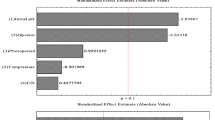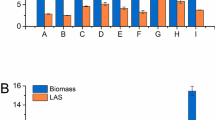Abstract
Temperature control is a very important factor on triterpene productivity in submerged liquid fermentation. Temperature effects from 23 to 32 °C on triterpene production by Ganoderma lucidum G0119 were investigated in 6-L stirred fermentor. Logistic and Luedeking-Piret equations were used to estimate the mycelial growth and triterpene production kinetics by regression analysis. On that basis, a temperature-shifting fermentation control strategy was established. From 0 to 61 h, culturing was performed at 32 °C to get high specific mycelial growth rate. Between 62 and 127 h, the temperature was decreased stepwise from 31 to 30 °C to maintain high triterpene productivity. After 128 h, temperature was maintained at 29 °C to minimize triterpene production inhibition and sustain high productivity. Elevated triterpene level (0.269 g L−1), yield (0.0101 g g−1), and productivity (0.00207 g (L h)−1) were achieved representing 27.32, 13.94, and 37.11 % higher than submerged liquid fermentation at constant temperature of 29 °C, respectively, feasible for the industrial scale.





Similar content being viewed by others
References
Liang, C. X., Li, Y. B., Xu, J. W., Wang, J. L., Miao, X. L., Tang, Y. J., Gu, T. Y., & Zhong, J. J. (2010). Enhanced biosynthetic gene expressions and production of ganoderic acids in static liquid culture of Ganoderma lucidum under phenobarbital induction. Applied Microbiology and Biotechnology, 86, 1367–1374.
Fang, Q. H., & Zhong, J. J. (2002). Effect of initial pH on production of ganoderic acid and polysaccharide by submerged fermentation of Ganoderma lucidum. Process Biochemistry, 37, 769–774.
Chen, A. W. (2007). Potential benefits of Ling Zhi or Reishi mushroom Ganoderma lucidum (W. Curt.: Fr.) P. Karst. (Aphyllophoromycetideae) to breast cancer patients. International Journal of Medicinal Mushrooms, 9, 29–38.
Min, B. S., Gao, J. J., Nakamura, N., & Hattori, M. (2000). Triterpenes from the spores of Ganoderma lucidum and their cytotoxicity against meth-A and LLC tumor cells. Chemical and Pharmaceutical Bulletin, 48, 1026–1033.
El-Mekkawy, S., Meselhy, M. R., Nakamura, N., Tezuka, Y., Hattori, M., Kakiuchi, N., Shimotohno, K., Kawahata, T., & Otake, T. (1998). Anti-HIV-1 and anti-HIV-protease substances from Ganoderma lucidum. Phytochemistry, 49, 1651–1657.
Wu, T. S., Shi, L. S., & Kuo, S. C. (2001). Cytotoxicity of Ganoderma lucidum triterpenes. Journal of Natural Products, 64, 1121–1122.
Chang, C. J., Lin, C. S., Lu, C. C., Martel, J., Ko, Y. F., Ojcius, D. M., Tseng, S. F., Wu, T. R., Chen, Y. Y. M., Young, J. D., & Lai, H. C. (2015). Ganoderma lucidum reduces obesity in mice by modulating the composition of the gut microbiota. Nature Communications, 6, 7489.
Fang, Q. H., & Zhong, J. J. (2002). Submerged fermentation of higher fungus Ganoderma lucidum for production of valuable bioactive metabolites—ganoderic acid and polysaccharide. Biochemical Engineering Journal, 10, 61–65.
Tang, Y. J., & Zhong, J. J. (2002). Fed-batch fermentation of Ganoderma lucidum for hyperproduction of polysaccharide and ganoderic acid. Enzyme and Microbial Technology, 31, 20–28.
Shi, L., Ren, A., Mu, D., & Zhao, M. (2010). Current progress in the study on biosynthesis and regulation of ganoderic acids. Applied Microbiology and Biotechnology, 88, 1243–1251.
Xu, J. W., Xu, Y. N., & Zhong, J. J. (2010). Production of individual ganoderic acids and expression of biosynthetic genes in liquid static and shaking cultures of Ganoderma lucidum. Applied Microbiology and Biotechnology, 85, 941–948.
Ren, A., Li, X. B., Miao, Z. G., Shi, L., Jiang, A. L., & Zhao, M. W. (2014). Transcript and metabolite alterations increase ganoderic acid content in Ganoderma lucidum using acetic acid as an inducer. Biotechnology Letters, 36, 2529–2536.
Mu, D. S., Li, C. Y., Zhang, X. C., Li, X. B., Shi, L., Ren, A., & Zhao, M. W. (2014). Functions of the nicotinamide adenine dinucleotide phosphate oxidase family in Ganoderma lucidum: an essential role in ganoderic acid biosynthesis regulation, hyphal branching, fruiting body development, and oxidative-stress resistance. Environmental Microbiology, 16, 1709–1728.
Zhong, J. J., Xu, Y. N., Tan, G. Y., & Bai, L. (2014). Signal transduction engineering: a powerful platform technology for enhancing secondary metabolite production. New Biotechnology, 31, S23–S24.
Feng, J., Zhang, J. S., Jia, W., Yang, Y., Liu, F., & Lin, C. C. (2014). An unstructured kinetic model for the improvement of triterpenes production by Ganoderma lucidum G0119 based on nitrogen source effect. Biotechnology and Bioprocess Engineering, 19, 727–732.
Huang, H., Ridgway, D., Gu, T., & Moo-Young, M. (2003). A segregated model for heterologous amylase production by Bacillus subtilis. Enzyme and Microbial Technology, 32, 407–413.
Feng, J., Feng, N., Yang, Y., Liu, F., Zhang, J. S., Jia, W., & Lin, C. C. (2015). Simple and reproducible two-stage agitation speed control strategy for enhanced triterpene production by Lingzhi or Reishi medicinal mushrooms, Ganoderma lucidum ACCC G0119 (Higher Basidiomycetes) based on submerged liquid fermentation. International Journal of Medicinal Mushrooms, 17, 1151–1159.
Monod, J. (1949). The growth of bacterial cultures. Annual Review of Microbiology, 3, 371–394.
Luedeking, R., & Piret, E. L. (1959). A kinetic study of the lactic acid fermentation: batch process at controlled pH. Journal of Biochemical and Microbiological Technology and Engineering, 1, 393–431.
Coleman, T., Branch, M. A., & Grace, A. (1999). Optimization toolbox user’s guide, version 2. Natick: The MathWorks, Inc.
Acknowledgments
This work was supported by the Shanghai Municipality Agricultural Research Project Grant for Career Development of Young Talents (Shanghai Agricultural Research Youth 2015 No. 1–7) and Shanghai Academy of Agricultural Sciences Young Scientist Career Development Grant (No. ZP06).
Author information
Authors and Affiliations
Corresponding author
Rights and permissions
About this article
Cite this article
Feng, J., Feng, N., Zhang, JS. et al. A New Temperature Control Shifting Strategy for Enhanced Triterpene Production by Ganoderma lucidum G0119 Based on Submerged Liquid Fermentation. Appl Biochem Biotechnol 180, 740–752 (2016). https://doi.org/10.1007/s12010-016-2129-1
Received:
Accepted:
Published:
Issue Date:
DOI: https://doi.org/10.1007/s12010-016-2129-1




